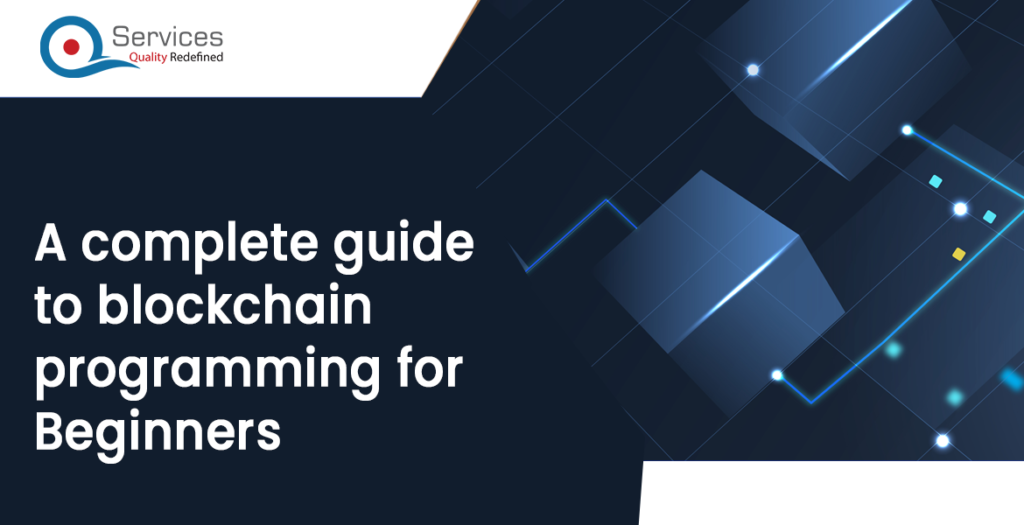Home » A Complete Guide to Blockchain Programming for Beginners

Let’s step into the world of Blockchain. In simple words, Blockchain does transactions on the Internet with appropriate information. As a result, it provides efficiency in the exchange of almost anything, which is why people trust Blockchain. Thus, Blockchain Development Companies can profoundly change the world’s work.
However, have you ever thought about how challenging it can be to track your medical records? Blockchain has the potential to store the technical information that redefines the processes, such as medical reports and many others. In short, when we talk about Blockchain, it’s not about bitcoin. Instead, it’s the digital foundation that supports applications such as bitcoin. But you see, Blockchain development companies are coming forward because Blockchain has extended far beyond bitcoin.
You will also know the difference between Blockchain and Blockchain for business and what makes Blockchain an ideal solution for simplifying business networks. Finally, this Blog will give you everything you need to spin up a blockchain network today.
Blockchain is a block that transmits the streamlined process of recording transactions and tracking assets in a business network.
In simple words, Blockchain is a technology that permits transactions to be gathered into blocks and in the recorded version. Moreover, it allows the resulting collection of decentralized blocks at different servers.
Such as patents, copyrights, branding, or virtually anything of value is tracked, and information is checked on a blockchain network. So, it reduces the risk and cuts costs for all involved. So that’s the platform address for Blockchain.
Now you will be thinking about what this decentralized and centralized Ledger is. Ledger means a collection of financial accounts.
Centralized Ledger: There are multiple ledgers or accounts in a centralized log, but the bank holds all accounts. This bank stores the “golden records of all.”
Suppose there are four people: Person A, B, C, and D. Client B wants to get his account information. Then he must reconcile its Ledger against that bank for account statements if any discrepancy arises.
There is one Ledger in which all nodes, i.e., intersection clients or persons, have the same level of access to that Ledger.
All interacting access points agree to a protocol of that system at any point in time. Applying these terms and conditions is sometimes called “achieving consensus.”
Suppose you are planning to invest in a blockchain Development Company but don’t know the process of Blockchain. Don’t worry, we will show you how it works in seven steps.
In short, Cryptography is the art of writing and solving codes. It’s a process of protecting data through codes so that only those for whom the information is intended can read and aggregate the data.
Current cryptography concerns itself with the following four objectives:
Confidentiality: The data cannot be understood by anyone for whom it was unintentional.
Integrity: The alteration of information in storage blocks cannot be changed or transit between senders if the receiver gets the detection of alteration.
Non-repudiation: Parties cannot deny the digital transaction and behavior in the trade in the Blockchain. Non-repudiation service intends to verify the collected information and provide undeniable evidence about messages from the sender to the receiver.
Authentication: The sender and receiver can verify each other’s originality, like the origin or destination of the information.
If you understand the Blockchain, you will appreciate blockchain potential. The paragraph below will highlight several use cases across various industries. We all know blockchain technologies are growing. Thus, we can see several applications in different industries.
Financial Services
The financial services company has several exemplary applications for Blockchain.
Commercial Financing
Traders mainly purchase goods and services on credit with end-to-end transparency to avoid and resolve dealing and transaction disputes.
For illustration purposes, let’s take IBM Global Financing companies. It provides finance to its global partners and encourages them to purchase goods and services from suppliers with credit authorized by IBM.
With over 4,000 plus confederates and suppliers using different systems, IBM drove all the information to the Blockchain and delivered it to users as a distributed ledger.
» Complete transparency of the order-to-delivery process.
» Reduction in the number of conflicts on the transaction.
» To reduce the time required to resolve disputes.
Businesses need a way to simplify obtaining approvals from multiple legal documents like customs, authorities, and trucking firms to move goods from one place to another. The Industrial Applications Blockchain app development makes it utilized for the legal entities to sign all clearances approval, and it keeps all parties notified regarding the approval status, when goods are received, and when payment is transmitted from the importers to the exporter’s bank.
The Benefits of Trade Finance Include the Following:
» Complex procedures simplified into a single approach, all accessing a shadow ledger.
» The increased entry of the capital will not take a long time in settlement times and reduce the error.
» Raised trust and accountability among enterprises during cross-border transactions.
After specifying challenges in your transaction network, consider various facts of Blockchain that can address the inefficiencies, expenditures, and other issues. For example, if a lack of trust generates friction, the Blockchain’s shared Ledger. We can increase the visibility of transactions and support histories to improve trust. Smart agreements may be the solution if trade protocols or rules cause delays. The goal is to determine how Blockchain can support and overcome specific challenges.
Blockchain is extremely valuable at boosting the level of trust among network parties. Because the transaction occurs on every other transaction, or any corruption is readily evident, thus everyone is effortlessly aware of it. This self-policing can meet the need to depend on the current level of legal or government safeguard. And sanctions to monitor and direct the flow of business transactions. The community of participants does that.
Where third-party oversight is directed, Blockchain reduces the responsibility on the regulatory system by making it easier for auditors and controllers to review relevant transaction details and verify subordination. And if you want to know how blockchain can benefit your industry, you are free to contact our Chief Technical Officer. We are always here to help you.

Founder and CEO

Chief Sales Officer
